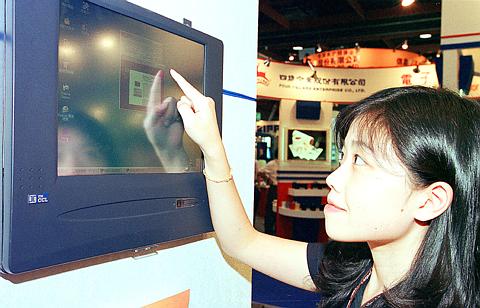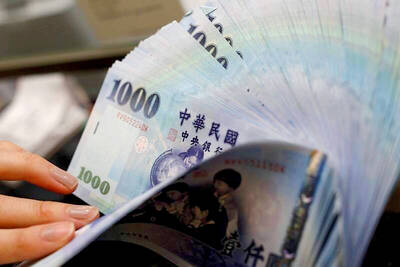Richard Wu did everything but get up on a soapbox and demand a new exhibition hall. At several media events leading up to this fall's Taitronics exhibition, Wu, chairman of the Taiwan Electrical and Electronic Manufacturers' Association (TEEMA), said again and again that the trade fair needs more space. With other regional electronics exhibitions gaining ground fast, he is not sure if Taipei will be able to build a new facility in time.
Taitronics is the biannual exhibition for Taiwan's electrical and electronics industry. The first half of its autumn installment -- components and equipment -- began yesterday at the main exhibition hall of the Taipei World Trade Center, and will run through Oct. 12. The second half of the fall show -- Finished Products -- will follow from Oct. 16 to 20.
The split of the fall Taitronics exhibition, which first happened last year, has caused no small amount of controversy among the show's organizers and local industry. The division was necessary because local companies' demand for participation was surging well beyond the physical limitations of the Trade Center's exhibition hall. With no other facilities available, show organizers were left with no choice but to cut the exhibition into two neat halves. However, the decision hasn't gone over well with everyone, most notably foreign buyers.

PHOTO: CHIANG YING-YING, TAIPEI TIMES.
"I would much rather see the two together," said one buyer from the US. "After I leave here I'm going to two other shows, one in Korea and one in Hong Kong. I won't have the time to come back to Taipei."
"It's terrible!" commented another buyer from Paris. "It's totally ridiculous. You have to go all the way home again and then come back for another show. They need to have it in one week with the two shows together."
Richard Wu agrees. In a prepared statement released before the show, he addressed the bleak prospects for a new facility. He first commented that the new exhibition hall planned for Nankang by the Ministry of Economic Affairs would be unable to meet the requirements of a sizable exhibition like Taitronics. In the same statement, Wu went on to praise Taipei Mayor Ma Ying-jeou for his intention to construct a large scale exhibition facility in a vacant military facility on Minchuan East Road across from the Sungshan Airport. The Minchuan Road facility, however, will likely take years to complete should it ever get off the ground.
In other speeches related to the Taitronics exhibition, Wu remarked that several Asian trade fairs were poised for significant growth, and could potentially overtake Taipei's dominant position. He specifically mentioned Chinese exhibitions like Shenzhen, Xiamen, and Shanghai, saying that the Chinese government is setting its sights on high-tech and pulling out all stops to get there. He further noted that Hong Kong was establishing new research facilities that could one day rival Taiwan's Hsinchu Science based Industrial Park.
For the time being, however, Taitronics is still one of Asia's strongest electronics exhibitions. The show can expect at least 3,000 foreign buyers each spring and around 10,000 for the two shows in the fall. The fall season is stronger because it gives buyers a chance to stock up on new products in time for the Christmas shopping season.
Show sponsors CETRA and TEEMA have announced that the current components and equipment exhibition includes 970 exhibitors in 1,881 booths. High participation and the small scale nature of the industry have kept booth sizes small.
The two sponsors further disclosed that the exhibition has seen limited effects from the Sept. 21 earthquake. According to K.H. Wu, deputy chairman of CETRA, two local exhibitors have cancelled as a result of damage suffered from the quake, though no foreign exhibitors have pulled out. The most significant drop, he said, would come in attendance of foreign buyers, which he predicted would fall 14 percent below original estimates.
The last exhibition held at the Taipei World Trade Center, Taipei Plas (Sept. 30 to Oct. 4), also saw a 20 percent drop in foreign attendance as a direct result of the earthquake.

Merida Industry Co (美利達) has seen signs of recovery in the US and European markets this year, as customers are gradually depleting their inventories, the bicycle maker told shareholders yesterday. Given robust growth in new orders at its Taiwanese factory, coupled with its subsidiaries’ improving performance, Merida said it remains confident about the bicycle market’s prospects and expects steady growth in its core business this year. CAUTION ON CHINA However, the company must handle the Chinese market with great caution, as sales of road bikes there have declined significantly, affecting its revenue and profitability, Merida said in a statement, adding that it would

Greek tourism student Katerina quit within a month of starting work at a five-star hotel in Halkidiki, one of the country’s top destinations, because she said conditions were so dire. Beyond the bad pay, the 22-year-old said that her working and living conditions were “miserable and unacceptable.” Millions holiday in Greece every year, but its vital tourism industry is finding it harder and harder to recruit Greeks to look after them. “I was asked to work in any department of the hotel where there was a need, from service to cleaning,” said Katerina, a tourism and marketing student, who would

i Gasoline and diesel prices at fuel stations are this week to rise NT$0.1 per liter, as tensions in the Middle East pushed crude oil prices higher last week, CPC Corp, Taiwan (台灣中油) and Formosa Petrochemical Corp (台塑石化) said yesterday. International crude oil prices last week rose for the third consecutive week due to an escalating conflict between Israel and Iran, as the market is concerned that the situation in the Middle East might affect crude oil supply, CPC and Formosa said in separate statements. Front-month Brent crude oil futures — the international oil benchmark — rose 3.75 percent to settle at US$77.01

RISING: Strong exports, and life insurance companies’ efforts to manage currency risks indicates the NT dollar would eventually pass the 29 level, an expert said The New Taiwan dollar yesterday rallied to its strongest in three years amid inflows to the nation’s stock market and broad-based weakness in the US dollar. Exporter sales of the US currency and a repatriation of funds from local asset managers also played a role, said two traders, who asked not to be identified as they were not authorized to speak publicly. State-owned banks were seen buying the greenback yesterday, but only at a moderate scale, the traders said. The local currency gained 0.77 percent, outperforming almost all of its Asian peers, to close at NT$29.165 per US dollar in Taipei trading yesterday. The